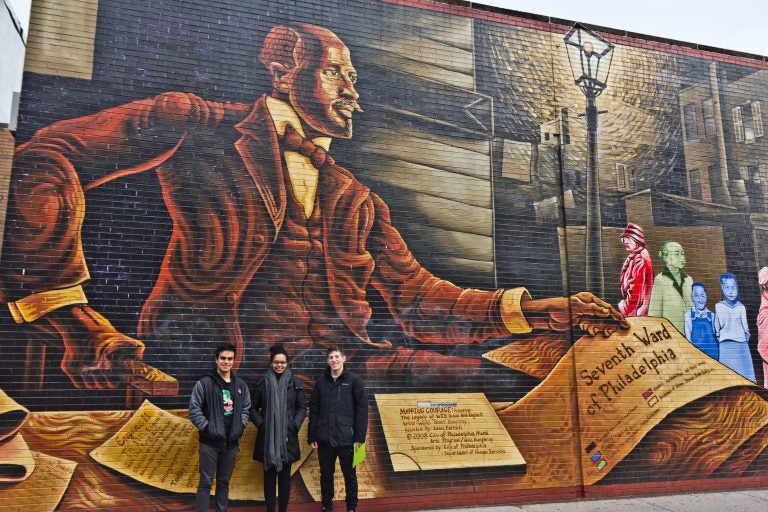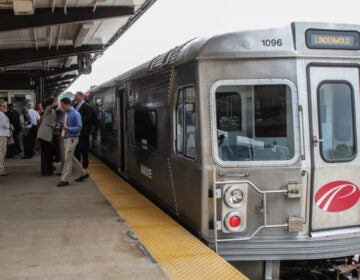Finding history on South Street

Let’s take a walk along South Street. In particular, let’s trace the footprints of black culture on the neighborhood. Penn students studying African-American history take WHYY News’ Danielle Fox to the homes of sociologist, race scholar, and civil rights activist W.E.B. Du Bois and Robert Adger, whose son would be the first black graduate at Penn. Du Bois made his mark in sociology as the first to illustrate structural racism and its effects combining his “research with census data to create visual illustrations of his findings in bar graphs,” writes ThoughtCo. Du Bois conducted more than 5,000 door-to-door interviews for his groundbreaking study “The Philadelphia Negro,” which, Fox writes, “unpacked how the legacy of slavery and the exclusion of African-Americans from the city’s top industrial jobs had shaped the condition of black people in the neighborhood.” The walk concludes with the former Standard Theatre, the first South Philly theatre primarily for the black community.
Zombie tower
If you’re gonna do away with a sizable chunk of the oldest and most intact jewelry district in the country, you better make something worthwhile in its place. With its Jewelers Row tower, Toll Bros. royally fails to do this, Inga Saffron writes. The building that Toll plans to plunk down on Samson Street overlooking Washington Square was designed by a firm that “primarily turns out construction drawings for more polished architects,” robs the public and gives nothing in return for the “rich history that Toll is destroying.” Saffron rails at the lobotomized design, the “lifeless” product of a routinely and carelessly gutted work as a quick and cheap response to each critique from the Washington Square neighborhood association or design review board. And that’s if Toll builds it at all. Saffron speculates that the developer may very well flip the property once it has all the necessary approvals in hand, as it did the former Society Hill Playhouse. Back when the drawings were unveiled, Ashley Hahn asked SLCE Architects partner Jim Davidson the very fair question: But why should this be a background building? “Because it is a background building,” he said flatly.
Building in social impact
Two years in as the Philadelphia Redevelopment Authority executive director, Greg Heller talks with Hidden City’s Nathaniel Popkin about bringing “investment to undercapitalized neighborhoods” through a strategy that returns publicly owned land to active use in ways that benefit for people and communities. Heller, who joined city government after years working in the nonprofit development sector, describes a policy he introduced at PRA and has seen adopted by the Department of Planning and Development. “One small but powerful tool implemented by the city in real estate proposals citywide is requiring development partners to describe their project’s “social impact” when bidding on public land,” Heller said. Heller offers two examples of how the social impact approach is yielding results: a mixed-use development at 8th and Race streets in Chinatown will include affordable housing for seniors and a new office building where 25 public-interest law organizations will co-locate. Another project at 36th and Haverford in Mantua will include a community grocery store and affordable housing. “We didn’t require or define any of these [social impact] elements,” Heller said. We left the projects totally open-ended in the RFP, and the developers came up with these great community-serving projects and partnerships. We believe that the best results will come from incentivizing rather than legislating, showing that the City is a willing partner, and nudging the private sector to innovate.
Kenney’s budget for smarties
Meta rundown! What would a delayed reduction of the wage tax for residents to 3.84 percent in the next five years instead of the 3.7 percent laid out in the existing schedule mean for us taxpayers? And what would a hike in the real estate transfer tax to 4.45 percent mean for the city? How often does the city raise property taxes anyway? Mayor Kenney unveiled his latest budget proposal Thursday, read up on this quick rundown by the Philadelphia Inquirer’s Laura McCrystal to prepare yourself to be the budget know-it-all at the water cooler. Jake Blumgart has more details from the annual address, including specifics on plans to increase funding for clearing blight and a commitment of $60 million over five years to advance Vision Zero projects.
WHYY is your source for fact-based, in-depth journalism and information. As a nonprofit organization, we rely on financial support from readers like you. Please give today.







